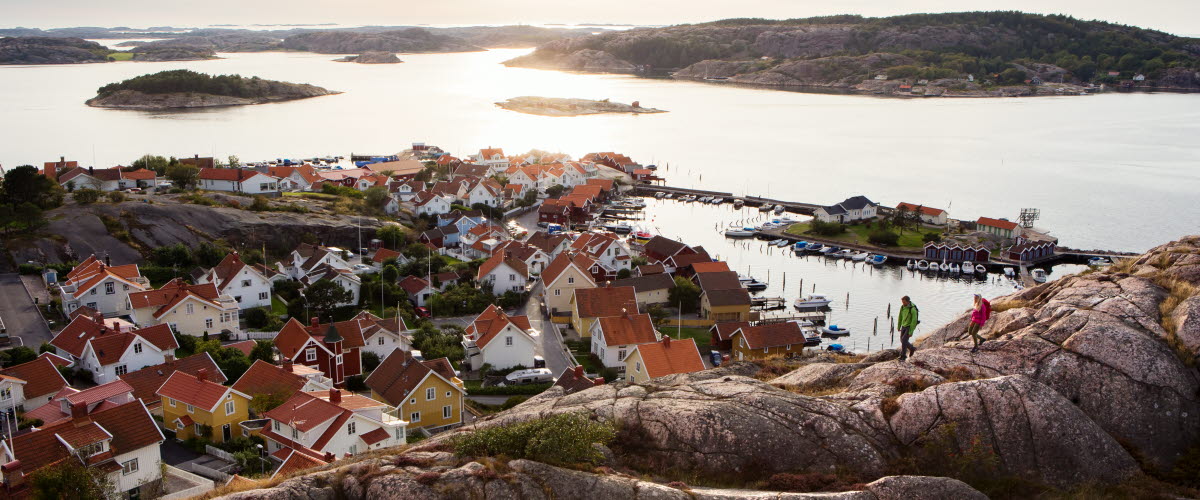Natural attractions in West Sweden
West Sweden is renowned for its natural attractions, landscapes and scenery – from the dreamy Bohuslän coast and stunning archipelago, to Europe’s nearest wilderness in Dalsland province and the plains, hills and forests of the province of Västergötland
The wilds of Dalsland
Wild Dalsland (called a landskap in Swedish) lies west of giant Lake Vänern, the largest lake in the EU. Often referred to in Sweden as ‘Sweden in miniature’ it has the open plains, deep forests and myriad lakes often associated with the country. Dalsland offers wild nature adventures like zip-lining, mountaineering, canoeing and mountain biking, as well as more sedate pursuits like hiking, camping, foraging and horse-riding trips.
Photographe: Christiane Dietz
No other area of Sweden has as many lakes, waterways and canals as Dalsland. In fact, Sweden’s biggest lake, Lake Vänern makes an appearance here in the southwest with its boating, fishing and lakeside slacking attractions. With a canal system measuring 250 kilometres in length, connecting Dalsland’s lakes, you would think canoeing would be top of mind. And it is. Families, friends, serious canoeists et al come here to navigate what used to be the waterway transport routes for timber and iron ore and find themselves in a watery paradise with plenty of great accommodation options.
The Bohuslän coast – you are going to love this!
The Bohuslän coast runs almost 280 kilometres up Sweden’s west side, from the city of Gothenburg all the way up to Norway. Off the coast there are 8,000 islands and up until about a century ago the people of the coast and island relied on the humble herring and quarrying rock for a living. Those are the bare facts, now comes the really good stuff.
Photographe: Roger Borgelid
The coastline is packed with small fishing villages among the smooth granite rock and they are perfect stop offs for sunning, bathing and maybe a spot of crab fishing. If you are staying longer you can book self-guided and guided kayaking tours of some of the islands, including Kosterhavet National Park, Sweden’s first marine national park that takes in the beautiful and car-free Koster and other islands. Here you can spot seals lolling in the waves or on the rocks, do a bit of island hopping, or even swim a ‘snorkel trail’ and spot some of the plants and creatures that live here. Down by the harbour in the towns of Grebbestad, Fjällbacka and Strömstad local fisherman would be only too happy to take you out to bait and haul in lobster (from end September), langoustine and crab (best thing is that on most of these trips you get to taste or buy some of the spoils). For fishermen and fisherwoman (this is Sweden after all), on the river Öreskilsälvan there could be a large salmon with your name on it, while in the waters offshore the first sea trout of the season is waiting to be hooked.
Photographe: Henrik Trygg
A truly fabulous way of experiencing the Bohuslän coast and inland is by hiking or cycling. You can walk or cycle Kuststigen (the coast trail) and the 370 kilometre long Bohusleden, that starts in Gothenburg in the south and stretches all the way to the seaside town of Strömstad in the north.
Nature action in Västergötland
Västergötland is where the central Swedish plain meets giant Lake Vänern in the north, this part of its coastline alone is 330 kilometres long. The province is bordered in the southeast by not-so-giant, but still very large Lake Vättern and the province’s hilly region. Luckily for hikers and trekkers there are many fine walking trails around the area that take you to its most beautiful landscapes and natural/cultural sights.
Photographe: Roger Borgelid
One of these is the scenic and natural 100 km long Pilgrim trail and another is the part man-made and part natural Göta Canal. Usually trafficked by private and passenger boats, walking or cycling the towpath here lets you see and experience the locks, villages, towns and sights along the canal, and there are plenty of cafés, restaurants and accommodation along the way.
Photographe: Åsa Dahlgren
If want a relaxing cycling holiday try the 150 kilometre long Sjuhäradsrundan cycling route that takes in more than 1,000 lakes, deep forest, and an area as rich in flora and fauna as it is cultural/heritage sights. Most of the route (120 kilometres) is on old railway embankment, so there is no traffic to worry about.
In springtime every year thousands of cranes gather to dance at Hornborga lake. And they are only outnumbered by the 150,000 visitors who come to see them.
While you are here you should pay the fabulous Naturum exhibition centre a visit for info about the lake, surroundings, walking trails and other activities on offer. The best vantage point for seeing all the action is at Utsikten (the view) that is across the footbridge from the exhibition centre. Hornborga lake and surroundings make for a fantastic day out for the entire family, especially if you come in the spring for the dancing cranes.



